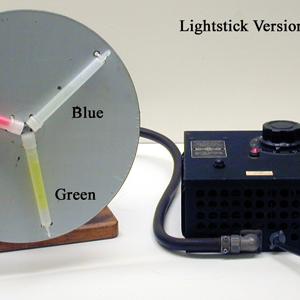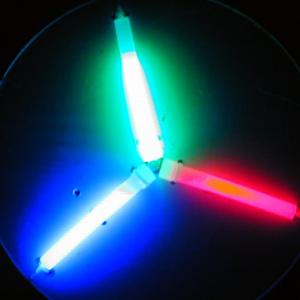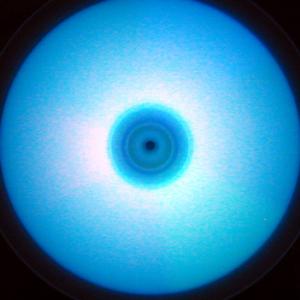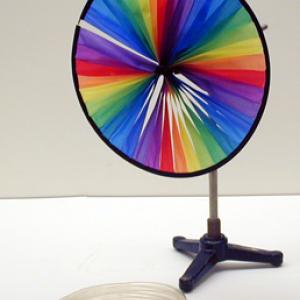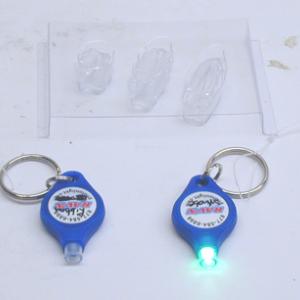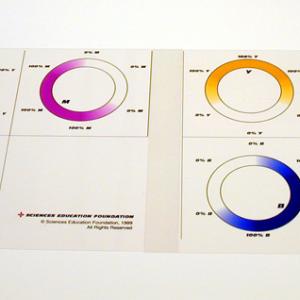College of Liberal Arts & Sciences
6F10.25 - Color Wheels
The color wheels may be hooked to a variety of our DC motors using the proper shaft adapters available. The motor used depends on your particular desires. As the speed of the motor is increased the wheel should traverse the colors of the spectrum until you reach a speed where the disk is a creamy white.
Attach the light sticks to the wheel with some plastic straps. Snap the light sticks so that they start to glow. Rotate the wheel and see a nice bright white color produced. The light sticks will last up to two hours.
- John Clement, "Clarifying Confusion", TPT, Vol. 37, # 6, p. 326, Sept. 1999.
- Lawrence D. Woolf, "Comments from Woolf", TPT, Vol. 37, # 6, p. 326, Sept 1999.
- Lawrence D. Woolf, "Confusing Color Concepts Clarified", TPT, Vol. 37, # 4, p. 204, April 1999.
- Leonard Parsons, "As Easy as R, G, B", TPT, Vol. 36, # 6, p. 347, Sept. 1998.
- Richard A. Bartels, "A Hallway Display of Additive Color Mixing", TPT, Vol. 24, # 9, p. 565, December 1986.
- Gordon R. Gore, "A Different Way to Use Newton's Color Wheel", TPT, Vol. 20, # 2, Feb. 1982, p. 101.
- Thomas B. Greenslade, Jr., "Color Wheel, AJP, Vol. 90, #11, Nov. 2022, p. 860.
- Thomas B. Greenslade, Jr., "Color Disk", AJP, Vol. 89, #3, March 2021, p. 243.
- H. L. Armstrong, "Comment on Newton's Inclusion of Indigo in the Spectrum", AJP, Vol. 40, #11, Nov. 1972, p. 1709.
- George Viernson, "Why Did Newton See Indigo in the Spectrum?", AJP, Vol. 40, # 4, Apr. 1972, p. 526.
- Oj-2: Freier and Anderson, A Demo Handbook for Physics.
- O-710: "12-in-1, Fan, and Colored Disk", DICK and RAE Physics Demo Notebook.
- Neil Ribe and Friedrich Steinle, "Exploratory Experimentation: Goethe, Land, and Color Theory", Physics Today, p. 43, July 2002.
- George M. Hopkins, "New Chromatrope", Experimental Science, p. 218.
- George M. Hopkins, "Light", Experimental Science, p. 214.
- George M. Hopkins', "Newton's Disks", Experimental Science, Volume Two, p. 103.
- Jodi and Roy McCullough, "Color Mixing with a Color Top and Color Fall", The Role of Toys in Teaching Physics, p. 4.41.
- Charles Vivian, "All Colors Produce White", Science Experiments & Amusements For Children, p. 54.
- Borislaw Bilash II, David Maiullo, "Color Addition", A Demo a Day: A Year of Physics Demonstrations, p. 320.
- Janice VanCleave, "50, Color Wheel", Teaching the Fun of Physics, p. 81.
- Janice VanCleave, "Blender", Physics for Every Kid - 101 Easy Experiments in Motion, Heat, Light, Machines, and Sound, p. 190-191.
Disclaimer: These demonstrations are provided only for illustrative use by persons affiliated with The University of Iowa and only under the direction of a trained instructor or physicist. The University of Iowa is not responsible for demonstrations performed by those using their own equipment or who choose to use this reference material for their own purpose. The demonstrations included here are within the public domain and can be found in materials contained in libraries, bookstores, and through electronic sources. Performing all or any portion of any of these demonstrations, with or without revisions not depicted here entails inherent risks. These risks include, without limitation, bodily injury (and possibly death), including risks to health that may be temporary or permanent and that may exacerbate a pre-existing medical condition; and property loss or damage. Anyone performing any part of these demonstrations, even with revisions, knowingly and voluntarily assumes all risks associated with them.

